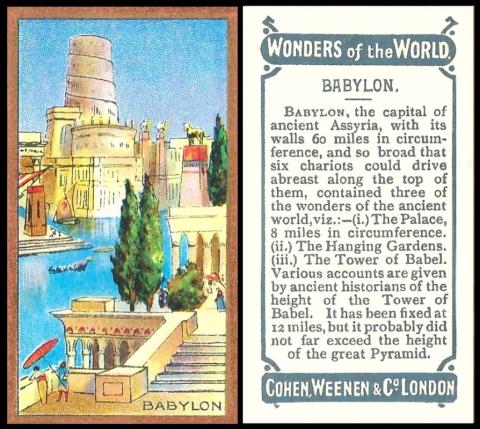
so why, you may ask, do we have a card of ancient Babylon? Well the answer is because this is where fingerprints were actually first used as a means of identification, all the way back to the reign of King Hammurabi, almost two thousand years before the birth of Jesus Christ. And their primary use was exactly the same as our Indian Magistrate, to seal a contact so that there was no dispute at a later date. And, even more startling, the Babylonians also routinely took fingerprints from anyone caught committing a crime.
This can be a confusing set, because not only did Cohen Weenen issue two sets with the title of "Wonders of the World", the subjects and pictures are the same. The only difference is that the first version has standard white borders and the second, ours, was gifted these super golden ones.
Yet if you look at our original World Tobacco Issues Index this rather important fact is entirely missing. So, without thinking, or without knowing, you have a choice of either C102-36 - Series No.6 - WONDERS OF THE WORLD. Sm. Unnd. (30). See H.104 - or - C102-53 WONDERS OF THE WORLD. Sm. 63 x 36. Unnd. (30). See H.104. Admittedly they are in different sections of the Cohen Weenen listing, the first being under section 4, "Series 1 to 6, issued 1904-1909. Small size 63 x 35 m/m, unless stated", with the second being under section 6. which simply says "Issues 1923 - 26".
However if you had a copy of the Handbook, published by the London Cigarette Card Company, a co-production between their Charles Lane Bagnall and our own Edward Wharton-Tigar, a look at H.104 immediately tells you :
Pre-1919 Inscribed "Series No.6". Plain borders to front
Post-1920 Gilt borders to front.
So why this did not appear in our volume I do not know. And it must have confused several collectors, because it has been added to our updated version of the World Tobacco Issues Index, where the first set now inserts "White border" between the "Sm." and the "Unnd" - and our set inserts "Gold border" between the "63 x 36." and the "Unnd."
There is a further note, because in many dealers catalogues you will find them catalogued in another way, the 1908 set being recorded as "Green Back", and our 1923 version as "Grey Back".
Now, strangely, the earlier set, despite the less exciting borders, definitely has more commercial value too, and as early as 1955 odd cards were being retailed at between 2/6 and 7/6 each, with sets at £12 - whilst our set was priced up at 6d. a card or 20/- a set.
